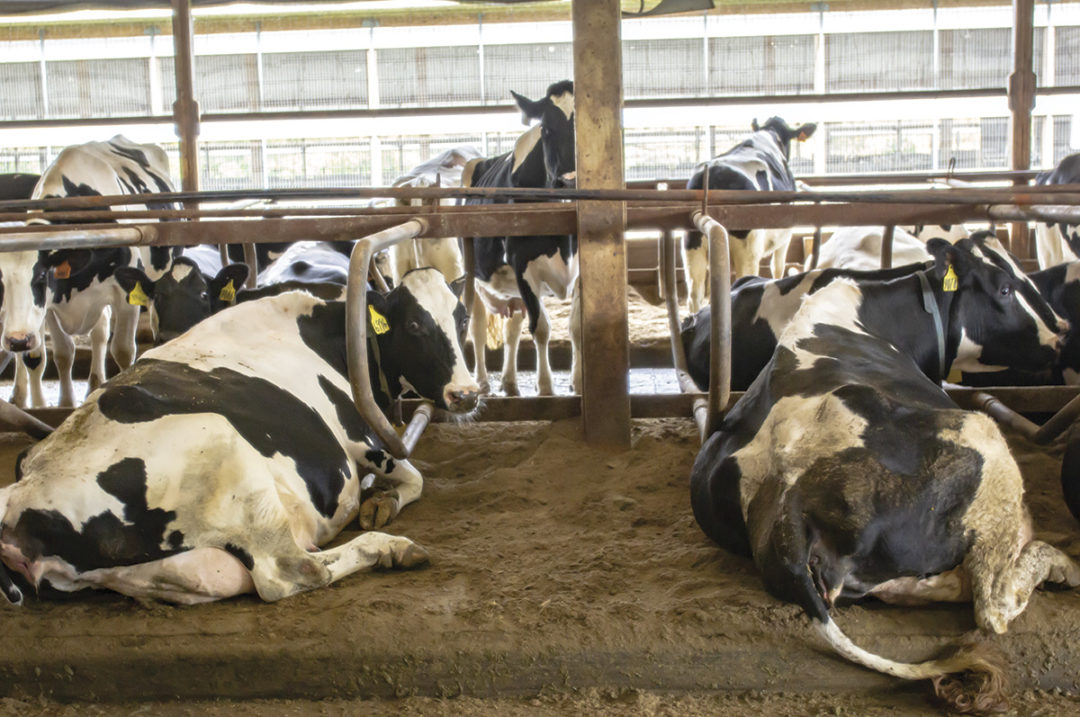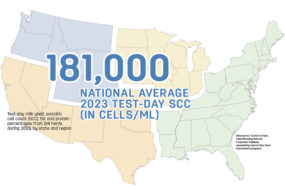Dairy producers who use recycled manure as bedding like that it is inexpensive and readily available, plus it helps with their sustainability footprint. What they do not like are the pathogens found in recycled manure that put their cows at greater risk for environmental mastitis and higher somatic cell count (SCC).
Controlling pathogen outgrowth in recycled manure bedding is possible. When a bacillus-based bedding additive was tested on-farm, a significant reduction in bulk tank SCC and mastitis cases was noticed.
Controlling environmental pathogens
Mastitis can be caused by either contagious or environmental pathogens. As the name suggests, environmental pathogens are present throughout a cow’s surroundings, especially in recycled manure bedding. When cows lie down, as they do for 10 to 12 hours each day, these bacteria come into contact with the ends of the teats, where they can then colonize the teat canal and cause a mastitis infection.
In an effort to characterize the mastitis-causing pathogens in dairy bedding, and ultimately develop an effective strategy to control the outgrowth of these organisms in the stall, more than 1,100 bedding samples were collected from dairies across the nation. Samples were collected from unused piles as well as from the stall, collected at the location of the udder. All types of bedding were sampled, including:
- Green recycled manure solids
- Solids from anaerobic digesters
- Composted manure solids
- Sand
- Other sources (straw, sawdust, wood shavings and cornstalks)
This initial survey sought to quantify and characterize target pathogens, including E.coli and total coliforms, organisms in the Klebsiella group, as well as those in the Group D streptococci group.
Turned to bacillus
The results led to a bedding additive which included bacillus strains with the best inhibition activity against environmental pathogens found in recycled manure bedding. Field trial results demonstrated a substantial reduction in E. coli, coliforms, Klebsiella and group D streptococci counts in bedding between the pretreatment and treatment periods. We also observed a reduction in bulk tank SCC counts and lower monthly clinical mastitis events.
Dozens of farms across the country have implemented this process into their bedding management. Columbia Ridge Dairy in South Dakota applies it to recycled manure as it leaves the screw press. As a longtime user of recycled manure bedding, farm manager Tim Timmons understands the impact that a reduction in mastitis-causing organisms in the bedding could have on cow health and well-being. Since applying a bacillus bedding additive, Timmons says the biggest impact has been on cases of clinical environmental mastitis.
“We especially saw a difference when we began using the additive,” Timmons says. “We see very few clinical cases of environmental mastitis anymore.”
Team effort to control environmental pathogens
In using additives for recycled manure bedding, a few keys to controlling environmental mastitis have been discovered:
- Controlling pathogens in recycled manure bedding is one piece of a complicated puzzle. Different management areas need to work together with bedding pathogen loads to impact the udder’s overall exposure to pathogens. This includes:
- Keeping alleys clean so manure doesn’t splash into the bedding area or up onto the udder when cows are walking.
- Regular stall grooming to remove manure or urine is important.
- Good parlor sanitation – We can do our best to keep stalls and barns clean, but if milking equipment is dirty, those efforts will not be effective. Good parlor protocols need to be followed to prevent environmental and contagious pathogens from entering the teat end during the milking process.
- Data analysis is important. Just like with any mastitis prevention program, it is important to understand as much as possible about the overall mastitis challenge on the dairy. Bulk tank SCC is one indicator; however, those numbers can be skewed by a small group of cows with extremely high SCC counts, preventing you from getting the real picture of what is happening at the farm level.
- Know your environmental risk. Culture your mastitis cases so you understand the type of pathogens creating the problem. If most of the mastitis-causing pathogens are of the contagious type, and not environmental, then protocols need to be put into place to control those specific pathogens. It’s likely, however, that if you’re using recycled manure as bedding, environmental pathogens are an issue.
Using recycled manure solids as dairy bedding is an economical and environmentally friendly practice. It becomes an even more viable option for producers when mastitis-causing pathogens in bedding can be safely and effectively controlled, thus reducing their negative impact on the health and well-being of the cow.






